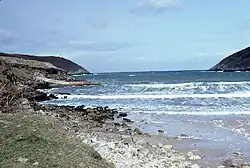Portacloy
Port an Chlóidh | |
|---|---|
Village | |
 Portacloy Bay | |
 Portacloy Location in Ireland | |
| Coordinates: 54°19′51″N 9°47′00″W / 54.33082°N 9.78337°W | |
| Country | Ireland |
| Province | Connacht |
| County | County Mayo |
| Area | |
| • Total | (Townland) 4.0277 km2 (995.28 acres) |
| Population (2011) | |
| • Total | 28 |
| • Density | 7.0/km2 (18/sq mi) |
| Port an Chlóidh is the only official name. The anglicised spelling Portacloy has no official status. | |
Portacloy (Irish: Port an Chlóidh)[1] is a Gaeltacht village and townland in northwest County Mayo, Ireland. In the barony of Erris and parish of Kilcommon, it is on the north of the Dún Chaocháin peninsula. The townland is on a horseshoe-shaped bay with two piers and several cliff walks. Portacloy townland has an area of approximately 995.3 acres (4.0277 km2)[2] and, as of 2011, had a population of 28.[3]
History
In 1812, "Clayport," situated at the eastern end of the village, became a site for sourcing clay used in earthenware production. The mining of pottery clay resumed in 1928 after samples underwent tests for making china earthenware.[4] The 1838 Ordnance Survey map revealed remnants of an old mill and the presence of a coastguard station and an English-built boathouse, established after the French landing at Killala.[5]
The Board of Works allocated £750 in 1841 for constructing a new road from Glenamoy to Portacloy, completed in 1846. Relief Works during 1846-1847 included building a new road from Portacloy to Cornboy Chapel, supported by grants. Further improvements were made in 1849 through a loan granted for estate enhancement.[5]
The Society of Friends, noted the challenges faced in fishing due to severe weather and the lack of secure landing ports in the Portacloy area. Efforts in the 1880s, led by Reverend Charles Cooney and others, aimed at securing a pier for Portacloy, met with resistance, citing the bay's exposure and limited resources for construction.[5]
The Congested Districts Board supported fishing development by establishing a curing station, recording significant mackerel catches by 1894. Subsequent advancements in fishing methods raised concerns about fish stocks, prompting a government warning to fishermen to reduce their catch. In 1909, the board facilitated the construction of a boat slip, breakwater, landing place, and approach road at Portacloy, alongside later developments such as a bridge and a pier built in the 1960s costing £26,000.[5] Telephone lines extended here during World War II for defence but ceased post-war.[6]
Geography
Benwee Head, standing tall at a height of 1000 feet above the sea, sits just beyond the entrance of the narrow inlet shaping the harbour. The terrain is rugged, primarily composed of marshland and mountains. The weather remains temperate with rare and short-lived frost or snow, yet heavy rains persist almost constantly for most of the year, accompanied by frequent and intense storms. Despite the flourishing vegetation, trees are sparse due to the relentless storms, only growing in sheltered areas.[7]
Portacloy Bay was a Green Coast Award Beach for 2017 and is the starting and finishing point for an 18km long loop walk.[8]
See also
References
- ↑ "Port an Chlóidh/Portacloy". logainm.ie. Retrieved 2023-12-31.
- ↑ "Portacloy Townland, Co. Mayo". www.townlands.ie. Retrieved 2023-12-31.
- ↑ "CD164 - Mayo Population by Private Households, Occupied and Vacancy Rate - data.gov.ie". data.gov.ie. Retrieved 2023-12-31.
- ↑ Western People, December 22, 1928
- 1 2 3 4 Noone, Fr. S. Where the Sun Sets (1991)
- ↑ Western People, January 3, 1948
- ↑ Browne, Charles R. "The ethnography of the Mullet, Inishkea Islands, and Portacloy, County Mayo." Proceedings of the Royal Irish Academy (1889-1901) 3 (1893): 587-649.
- ↑ "The Portacloy Loop - Cliff Walk, Walks in Co. Mayo West of Ireland | mayo-i". www.mayo-ireland.ie. Retrieved 2023-12-31.
External Links
![]() Media related to Portacloy at Wikimedia Commons
Media related to Portacloy at Wikimedia Commons
